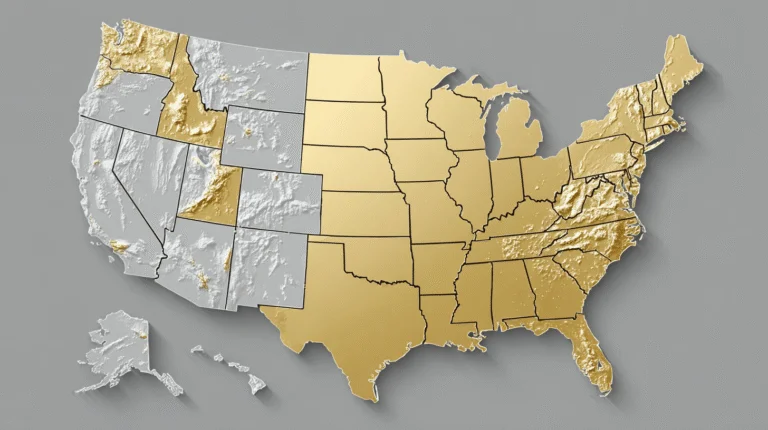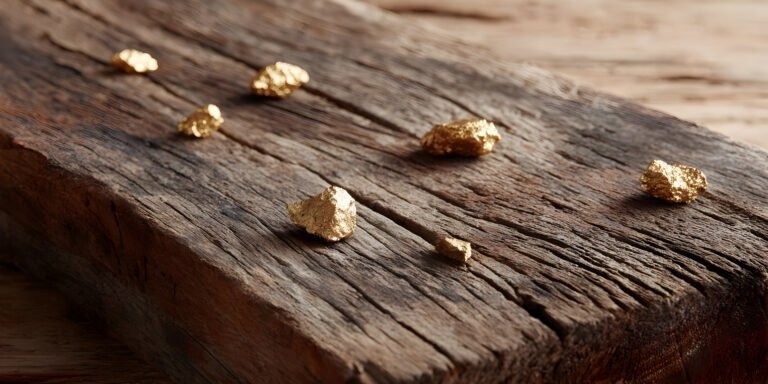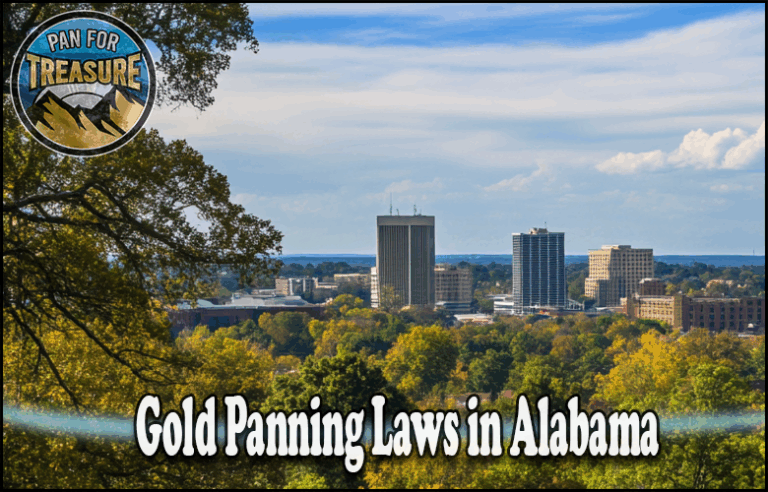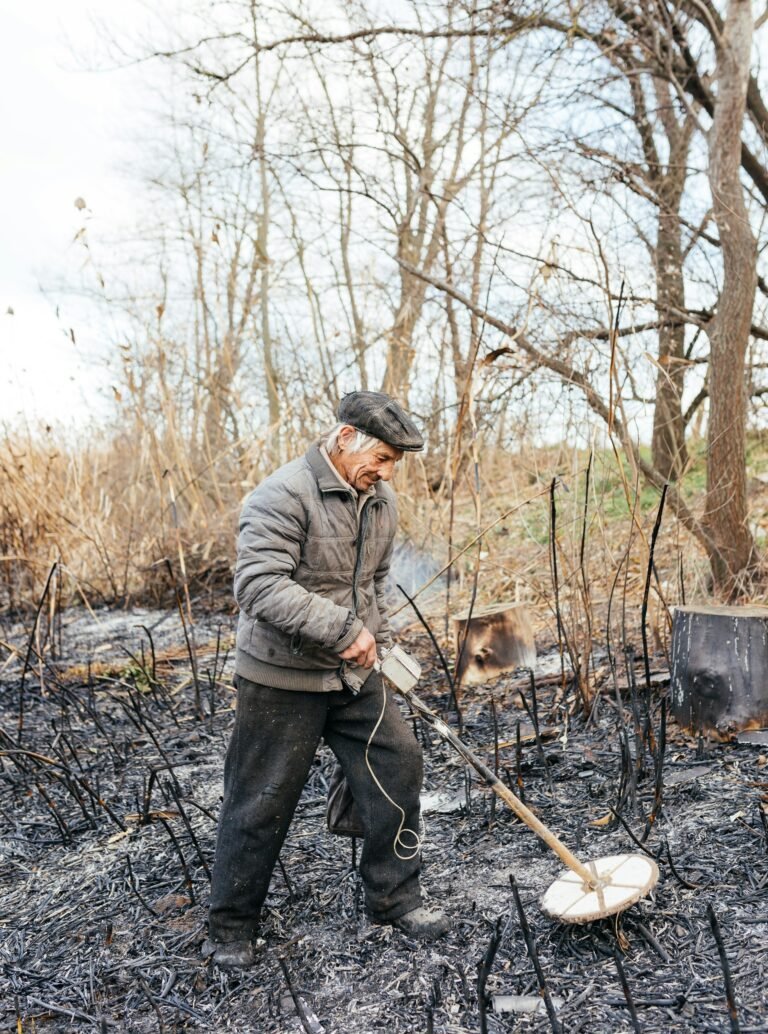
Disclosure: This Post Contains Affiliate Links; We earn a commission on purchases.
Alabama, known for its rich history and natural resources, has long been a source of fascination for prospectors and miners.
But is there gold in Alabama? The answer is a resounding yes. The state boasts a wealth of gold deposits and a significant history of gold mining.
Alabama’s gold mining potential is highlighted by the discoveries made in various counties.
The state experienced a gold rush in the early 1800s, leading to the establishment of mining towns and the extraction of both placer deposits and lode mines.
Counties such as Talladega, Elmore, Cleburne, Randolph, Chilton, Clay, Chambers, Tallapoosa, and Coosa have all seen the glitter of gold.
Gold exploration in Alabama often involves finding small grains of gold within rock formations. In the past, dangerous chemicals like cyanide and mercury were used to extract the precious metal.
While these methods have had a significant environmental impact, there is still potential for gold production in Alabama.
The state continues to offer opportunities for gold prospecting and exploration.
Key Takeaways:
- Alabama has a rich history of gold mining, with significant gold deposits found in various counties.
- The state experienced a gold rush in the early 1800s, leading to the establishment of mining towns.
- Dangerous chemicals like cyanide and mercury were once used to extract gold from Alabama’s mineral-rich areas.
- Despite the environmental impact, Alabama still holds potential for gold production.
- Opportunities for gold prospecting and exploration exist in the state.
Is there gold in Alabama?
Yes, gold is found in Alabama, particularly in the central and northeastern regions.
Areas like the Tallapoosa River, Arbacoochee, and the Hog Mountain district have a rich history of gold discoveries.
Today, recreational panners still find small gold flakes and nuggets in Alabama’s rivers, creeks, and streams.
History of Gold Mining in Alabama
Alabama holds a significant place in the history of gold mining in the United States. The state witnessed its own gold rush in the early 1800s, attracting prospectors from far and wide.
Some of the major gold discoveries were made at Chestnut Creek and Blue Creek in the 1830s, leading to the establishment of bustling mining towns like Goldville. At its peak, Goldville boasted a population of around 3,000 people, fueled by the promise of finding gold.
However, the gold rush in Alabama eventually waned in 1849 when many miners left to join the California Gold Rush.
Despite subsequent revivals of gold mining in the 1880s and 1900s, Alabama did not produce significant quantities of gold.
The impact of gold mining can still be seen in certain areas, with remnants of abandoned mine shafts and trenches scattered throughout the state.
The history of gold mining in Alabama, although marked by moments of boom and decline, holds immense historical and cultural significance.
It is a testament to the pioneering spirit and determination of those who sought their fortune in the pursuit of gold.
“The gold rush in Alabama brought forth a sense of hope and opportunity, forever shaping the landscape and communities of the state.”
As you explore Alabama’s gold mining history, it becomes evident that the legacy of gold mining is deeply ingrained in the state’s identity. It serves as a reminder of the individuals and towns that once relied on the gold industry for economic prosperity.
Although commercial mining may have declined, the historical sites and stories continue to captivate and inspire.
Gold Mining Towns in Alabama
During the gold rush, several mining towns emerged in Alabama, each with its own unique story. Goldville, as mentioned earlier, was one such town that experienced remarkable growth, fueled by the gold discoveries in the nearby creeks.
Other notable gold mining towns include Arbacoochee, Old Providence, Hog Mountain, and Gantt’s Quarry.
The Impact of Gold Mining in Alabama
The impact of gold mining in Alabama extends beyond the economic and cultural aspects. It has left its mark on the landscape, with abandoned mine shafts and trenches serving as a tangible reminder of the past.
The environmental consequences of gold mining, especially the use of chemicals like mercury and cyanide in the extraction process, have also had lasting effects on the surrounding ecosystems.
| Environmental Impact | Gold Mining Impact in Alabama |
|---|---|
| Contamination of groundwater | Adverse effects on flora and fauna |
| Disruption of ecosystems | Alteration of natural landscapes |
| Abandoned mine shafts and trenches | Remnants of gold mining activities |
Despite the environmental challenges, Alabama’s gold mining legacy remains a vital part of the state’s heritage.
Exploring the history, towns, and impact of gold mining in Alabama offers a glimpse into the past and an appreciation for the determination and resilience of those who shaped the state’s early days.
Locations to Find Gold in Alabama
If you’re looking to find gold in Alabama, there are several locations that hold promising potential. Whether you’re a seasoned prospector or a beginner, these gold-rich areas offer opportunities for panning and mining.
Here are some key locations to consider:
Talladega National Forest
The Talladega National Forest is a popular destination for gold prospecting on federal land. With its vast expanse of forests and streams, this area offers ample opportunities to search for gold. Take advantage of the open areas and untouched creeks to try your hand at panning for gold.
Arbacoochee District
The Arbacoochee district in Cleburne County is known for its productive gold mining sites in the past. This historic district has witnessed significant gold discoveries and continues to hold potential for finding gold deposits. Prospecting in this area can be a rewarding experience for those looking to uncover Alabama’s gold mining heritage.
Goldville
Tallapoosa County’s Goldville is another area with a rich gold mining history. This former mining town was once a bustling community during the gold rush era, and it’s still possible to find gold here today. Explore the creeks and rivers in Goldville for a chance to strike gold.
Chestnut Creek and Blue Creek
Chestnut Creek and Blue Creek are two locations where gold-rich deposits have been discovered. These creeks have yielded significant amounts of gold in the past, making them attractive prospects for gold panning and prospecting. Don’t miss the opportunity to explore these areas if you’re searching for gold in Alabama.
Clay County, Coosa County, and Cleburne County
In addition to the specific districts mentioned above, Clay County, Coosa County, and Cleburne County have been known to contain gold-rich areas. These counties offer a variety of potential locations for gold prospecting, from creeks and rivers to more remote areas. Consider exploring these counties to increase your chances of finding gold in Alabama.
Remember, proper research and the use of appropriate techniques and tools are crucial when prospecting for gold. Take your time to learn the best methods for panning and mining, and always follow local regulations and guidelines.
With determination and a bit of luck, you may uncover the treasures hidden in Alabama’s gold-rich landscapes.
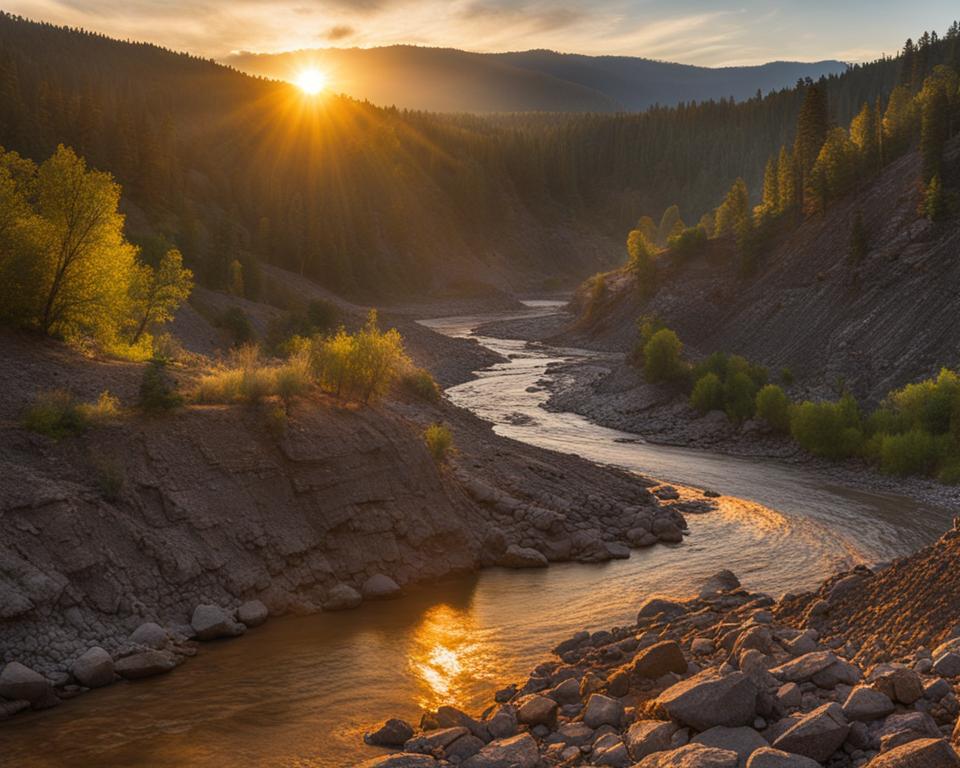
| Location | Description |
|---|---|
| Talladega National Forest | A popular destination for gold prospecting on federal land, known for its vast forests and streams. |
| Arbacoochee District | Cleburne County district with a significant gold mining history and potential for finding gold deposits. |
| Goldville | A former gold mining town in Tallapoosa County, where you can still find gold in the creeks and rivers. |
| Chestnut Creek and Blue Creek | Locations where gold-rich deposits have been discovered, offering excellent prospects for gold panning. |
| Clay County, Coosa County, and Cleburne County | Counties known to contain gold-rich areas, providing a variety of potential locations for prospecting. |
Gold Panning and Prospecting in Alabama
For those interested in gold panning and prospecting in Alabama, there are resources available. The Alabama Gold Camp is a popular destination for gold panning. They offer lodging, a general store stocked with supplies, and options for camping and RV hookups.
The camp may also provide equipment and experienced guides to assist beginners.
Gold panning can be a rewarding hobby, and Alabama offers opportunities for both recreational and hobbyist prospectors. Whether you’re a beginner or more experienced, there are gold prospecting supplies available in the state to support your passion for searching for gold.
Whether you’re panning for gold as a hobby or planning a prospecting adventure, the Alabama Gold Camp and the availability of gold panning supplies in Alabama make it easier for you to pursue your gold hunting dreams.
Environmental Impact of Gold Mining in Alabama
The gold mining activities in Alabama, particularly in the past, have had a significant environmental impact.
The use of chemicals such as mercury and cyanide to extract gold from the rocks has led to contamination of groundwater near mining locations.
This contamination poses a threat to the environment, wildlife, and human health.
“The remnants of abandoned mine shafts, vats, and trenches used during the gold mining process can still be found in certain areas,” says Dr. Emma Lawson, an environmental scientist. “These remnants serve as a haunting reminder of the environmental consequences of gold mining in Alabama.”
The release of mercury and cyanide into the environment has long-term effects on ecosystems and groundwater.
Mercury, in particular, can accumulate in the food chain, leading to bioaccumulation and biomagnification in aquatic organisms. This poses threats to fish populations and can impact both human and wildlife health.
Dr. Lawson advises, “It is crucial to consider the environmental impact and take necessary precautions when engaging in gold mining activities. These precautions include proper waste management, the use of non-toxic alternatives, and minimizing the use of chemicals.”
The Contamination of Groundwater
Gold mining activities often involve the use of cyanide solution to extract gold from the ore. This solution can seep into the groundwater, resulting in the pollution of water sources. The contaminated groundwater not only affects human populations but also impacts the surrounding ecosystems.
Mercury and Cyanide Exposure
Workers involved in gold mining operations may be exposed to high levels of mercury and cyanide. These chemicals can have detrimental effects on human health, causing neurological disorders, respiratory issues, and other serious health problems.
Protecting Alabama’s Environment
Efforts must be made to mitigate the environmental impact of gold mining in Alabama. Implementing strict regulations, promoting responsible mining practices, and investing in research for safer extraction methods are key to protecting the environment, wildlife, and local communities.
Gold Mining Heritage in Alabama
The legacy of gold mining in Alabama holds a significant place in the state’s history. The historical sites that remain, such as the once-thriving mining town of Goldville, offer a glimpse into the impact of gold mining on local economies and communities.
At its peak, Goldville boasted a population of over 3,000, bustling with miners seeking their fortune.
However, as the gold rush subsided, many of these towns faced a decline in population and economic activity. Today, the remnants of these mining towns serve as a testament to the hard work and determination of the miners who once sought gold in Alabama.
Exploring these historical sites allows visitors to immerse themselves in the rich heritage and dreams that were woven into the fabric of Alabama’s gold mining past.
Visiting these sites provides a unique opportunity to witness the remnants of the gold rush era, from abandoned mine shafts to the echoes of bustling communities.
Each step taken in these historical lands becomes a journey back in time, honoring the perseverance and ambition that shaped Alabama’s gold mining legacy.
Conclusion
In conclusion, Alabama’s rich history as a gold-producing state showcases its potential for gold mining and exploration.
The state has a long history of prospecting activities, especially in areas like Randolph County, Chambers County, and along the state line where placer deposits have been discovered in stream beds and near lakes like Martin Lake.
Prospectors still report finding flakes and even ounces of gold using traditional tools like sluice boxes in creeks such as Eagle Creek.
In addition to gold, Alabama’s rich geological makeup includes a variety of gem stones, making it an exciting destination for rockhounds and treasure hunters alike.
According to the Geological Survey of Alabama, mining deposits across the state continue to attract hobbyists looking to explore untapped areas.
Although the commercial gold mining industry has declined, Alabama still presents opportunities for gold prospecting and recreational gold panning.
Whether you’re searching for flakes, nuggets, or rare minerals, Alabama’s rivers, hills, and historical mining regions offer plenty of opportunity for modern-day gold seekers.
Gold Panning FAQs for Alabama
Is there gold in Alabama rivers?
Yes, gold has been discovered in several Alabama rivers, including the Tallapoosa River, Crooked Creek, and Wesobulga Creek. These areas have a rich history of gold mining and are still explored by hobbyists today.
Is there gold in Alabama creeks?
Alabama creeks in regions like Cleburne and Clay Counties have been known to carry small placer gold deposits, especially near old mining camps and upstream bends.
Is there gold in Alabama streams?
Yes, gold can be found in streams throughout Alabama’s gold belt. Prospectors often pan in shallow, slow-moving waters where gold flakes tend to settle.
Is there gold in Alabama today?
Gold panning is still alive and well in Alabama. While large-scale mining is no longer active, recreational prospectors continue to find small amounts of gold in the right locations.
Where can I pan for gold in Alabama?
Popular gold panning locations in Alabama include the Alabama Gold Camp near Lineville, the old mining grounds around Arbacoochee, and creeks in the Talladega National Forest. Always check access rules and land ownership before prospecting.
{
“@context”: “https://schema.org”,
“@type”: “FAQPage”,
“mainEntity”: [
{
“@type”: “Question”,
“name”: “Is there gold in Alabama rivers?”,
“acceptedAnswer”: {
“@type”: “Answer”,
“text”: “Yes. Gold has been discovered in several Alabama rivers, including the Tallapoosa River, Crooked Creek, and Wesobulga Creek. These areas have a rich history of gold mining and are still explored by hobbyists today.”
}
},
{
“@type”: “Question”,
“name”: “Is there gold in Alabama creeks?”,
“acceptedAnswer”: {
“@type”: “Answer”,
“text”: “Yes. Alabama creeks in regions like Cleburne and Clay Counties have been known to carry small placer gold deposits, especially near old mining camps and upstream bends.”
}
},
{
“@type”: “Question”,
“name”: “Is there gold in Alabama streams?”,
“acceptedAnswer”: {
“@type”: “Answer”,
“text”: “Yes. Gold can be found in streams throughout Alabama’s gold belt. Prospectors often pan in shallow, slow-moving waters where gold flakes tend to settle.”
}
},
{
“@type”: “Question”,
“name”: “Is there gold in Alabama today?”,
“acceptedAnswer”: {
“@type”: “Answer”,
“text”: “Yes. Gold panning is still active in Alabama. While large-scale mining is no longer active, recreational prospectors continue to find small amounts of gold in the right locations.”
}
},
{
“@type”: “Question”,
“name”: “Where can I pan for gold in Alabama?”,
“acceptedAnswer”: {
“@type”: “Answer”,
“text”: “Popular gold panning locations include the Alabama Gold Camp near Lineville, the old mining grounds around Arbacoochee, and creeks in the Talladega National Forest. Always check access rules and land ownership before prospecting.”
}
}
]
}
Source Links
- https://raregoldnuggets.com/?p=9045
- https://encyclopediaofalabama.org/article/gold-production-in-alabama/
- https://vacationsalabama.com/recreation/gold-prospecting-in-alabama/
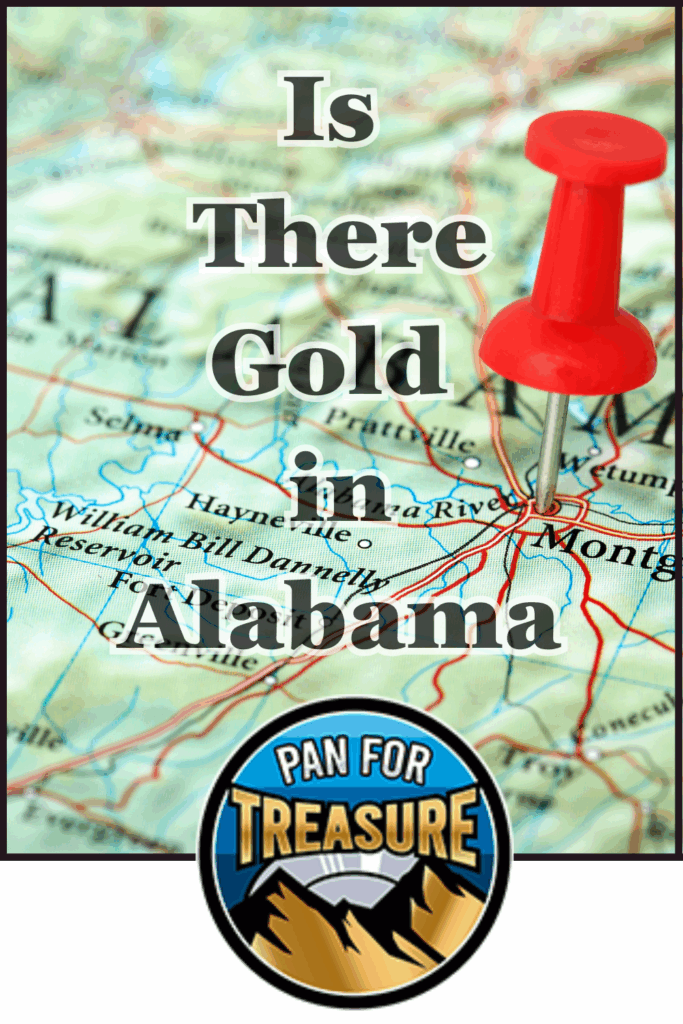

Meet Ryan Conlon, the passionate owner and driving force behind Pan for Treasure.
With an unwavering love for the art of gold panning, Ryan has transformed his enthusiasm into a thriving community hub for fellow treasure seekers. info@panfortreasure.com
A seasoned gold panning enthusiast, Ryan’s journey began with a simple pan and a dream, evolving into a deep appreciation for the history, geology, and thrill of uncovering precious metals.
Subscribe to Our Newsletter

